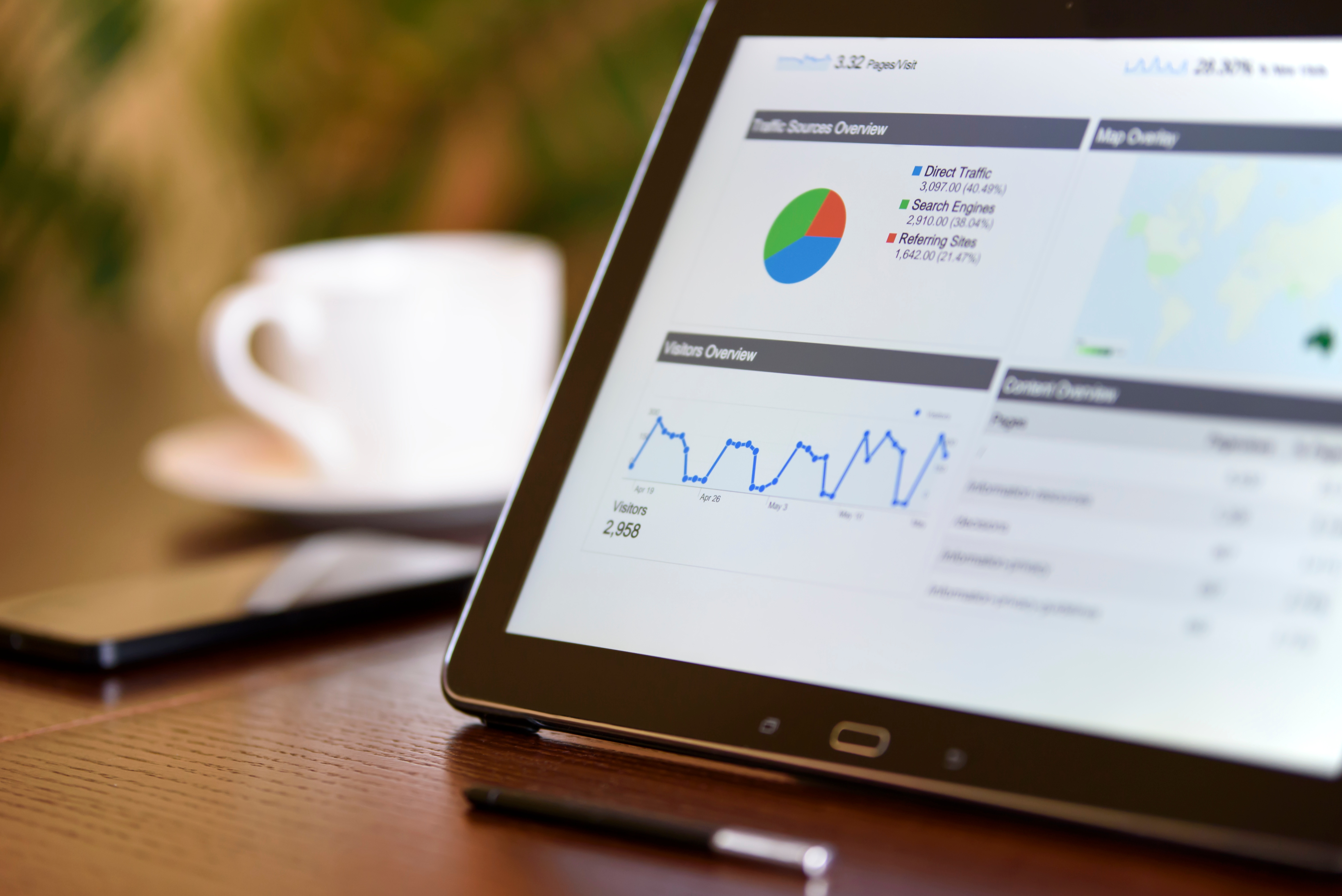Every year I look forward to sharing the annual Mary Meeker Internet Trends Report (she's a Partner at Kleiner Perkins Caufield & Byers (KPCB)), and does a fabulous job highlighting some major industry trends that we all should know about. This year her report was presented and published at the Code Conference at Rancho Palos Verdes, California.
I like to share the presentation with my Laurentian University BBA class. As we go through this presentation, my students finally get to understand the converging relationship between demographics, technology and marketing, and why understanding these trends is so important, to better understanding the consumer, and how marketing is always changing and adapting to these trends.
Mary Meeker gives a fascinating analysis of not only what Internet trends are developing, but she presents a vast array of Internet facts & stats, presenting an in-depth backgrounder of demographic data to validate her trends and predictions.
True to form, the 213 slides in her presentation are full of charts, graphs and data, and there is also an excellent video of her presentation (it’s a little long but well worth watching).
Here is a link to the video: https://youtu.be/334Gfug5OL0
Here is a link to the slides: http://www.kpcb.com/internet-trends
What's The General Direction Of These Trends?
She concludes that the days of easy and rapid Internet growth seem to be behind us, moist of the high ground has been staked. The trends are now showing that the Internet is slowing down, as global saturation increases, and that associated technology and platform growth is also consolidating and growing more slowly. However, the really interesting data, and the new opportunities, can now be found when focusing on the granular trends.
Additionally, over the years, as I've read through these reports, I’ve noticed that the relationship between companies and customers, and technology with individuals, is rapidly changing the way we handle information and interact with media, and with each other. This obviously has an impact on the way we look at marketing.
For example, consumers are becoming more and more savvy, and less inclined to receive media content that isn’t relevant to them. But on the flip side, if the information is relevant to them, they as consumers will embrace the information they deem pertinent – so the challenge remains in delivering relevant content in a seamless way that does not disturb their natural, native behaviors.
Another trend worth noting, is that as marketers, we need to think about the consumer first, and target them based not only on who they are, but how they behave online – and connect the contextual dots to the technology platforms they embrace.
The fundamentals of these Internet trends are not changing, they are just evolving. It’s no longer as simple as executing a typical marketing program mix, and dropping spend percentages across it. We have to be smarter than that and embrace the true multi-screen, on-the-go nature of today’s marketplace. We do this from an Inbound Marketing perspective by going deep on the persona and the buyers journey to better understand preferences and potential conversion points.
For those of you without the time to browse all 213 slides, I've picked out they key points from the Internet Report, from an Inbound Marketing perspective, so you can stay abreast of the latest trends. I’ve picked out my major takeaways from this, and listed them below.
Google and Facebook Are Dominating Online Ad Space
These two giants are quickly solidifying their positions as market leaders in the online ad space. Facebook managed a huge 59% year-on-year growth last year, taking ad revenues to $8 billion, whilst Google, who still dominates the market, earned almost $30 billion from PPC ads alone, as much as all other platforms combined.
As these platforms grow larger and more powerful, they'll be able to exert more and more control over online ads, and the targeting of these PPC ads is becoming incredibly granular. We now have Facebook announcing a plan to allow businesses to leverage their user data to deliver more targeted ads on other sites, which would be purchased via Facebook.
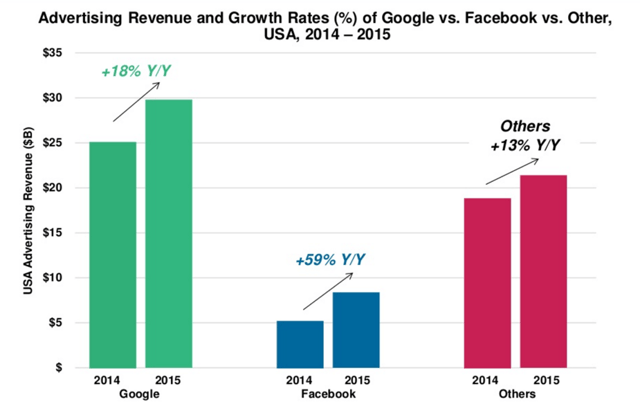
Mobile Ads Are Finally Here
It’s taken more that five years for mobile advertising to gain traction. Mobile advertising used to be a fringe activity that made up a tiny percentage of our ad budgets. Now, with over 50% of web traffic coming from mobile devices, and with $60 billion of mobile Internet spending in the US alone, it now accounts for a 3rd of all Internet ad spend. When we're booking Google or Facebook ads, mobile targeting is essential.
This graph also shows the strong growth in digital advertising generally. The rate for 2015 was the highest ever by a healthy $10 billion margin, and year-over-year growth also moved up last year to a rapid 20%.
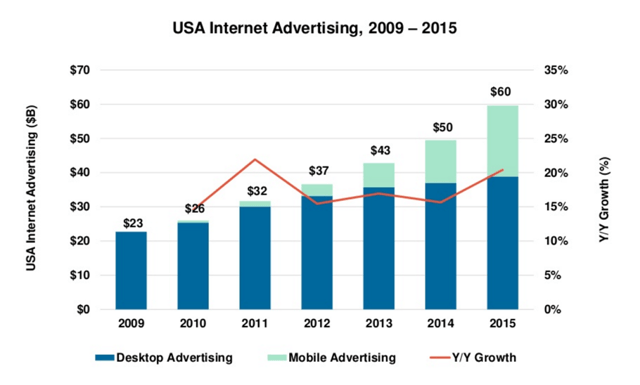
Smartphone Growth Is Now Only In The Emerging Markets
Last year we saw mobile outstrip desktop for the first time when it came to web traffic. This year we see Smartphone use continuing its strong growth, but now the biggest markets are in developing economies. Asia now makes up over 50% of the entire global smartphone user base, something marketers should bear in mind when looking to enter new markets in this region.
It also has implications for those already marketing in Asia. If you haven't already adopted a 'mobile first' approach your customers may go elsewhere, given that they're highly likely to be using mobile devices to view your content.
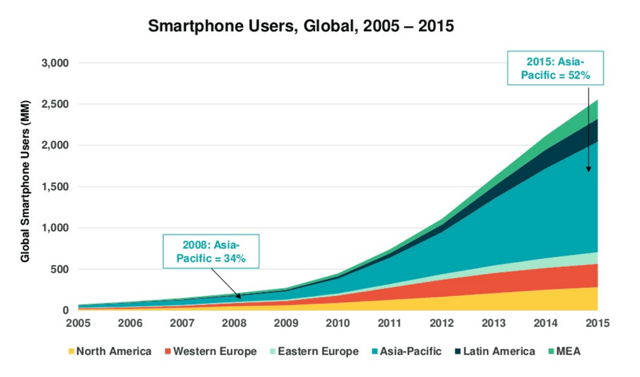
Mobile Ad Blocking Becomes Mainstream
Desktop ad blocking had grown massively in popularity, but wasn't really an option for most mobile users, until recently. That has now changed and mobile ad blocking rates have soared.
Some 200 million more people are now blocking ads on their mobiles than they were last year. This presents a challenge for advertisers who will increasingly have to get around this via either, in-app advertisements, or more targeted mobile content marketing tactics.
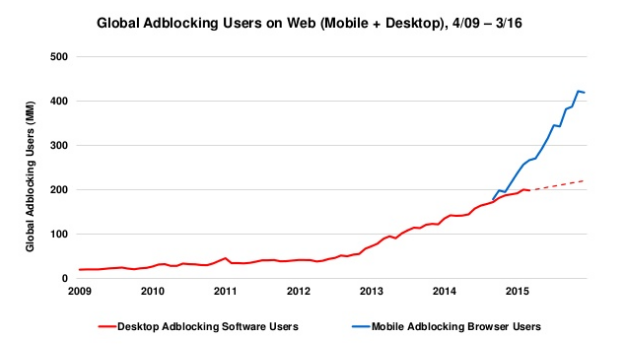
Ecommerce Continues To Grow Rapidly
Ecommerce growth is hardly a new trend, but it is worth mentioning the continued rapid growth in the sector. American spending online reached a massive $340 billion last year, up considerably on the previous year. Ecommerce now makes up over 10% of total retail sales, not a bad chunk of the market, but one that leaves it with plenty of room to grow.
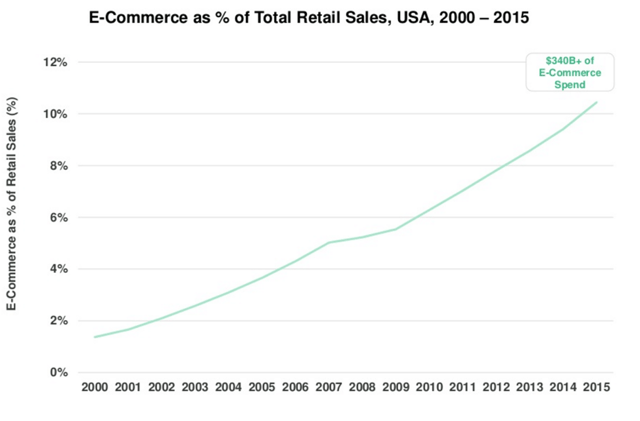
Video Is Going Social
A few years ago, YouTube was the 800lb gorilla in the market, and then, maybe Vimeo and Daily Motion, for the really switched on.
This has changed over the past couple of years, as social sites have woken up to the potential of hosting videos on their own platforms.
Facebook's daily video views have shot through the roof over the course of last year, reaching a massive 8 billion per day by Q3 last year. Snapchat has done even better, growing 10x over the course of a year to 10 billion daily video views.
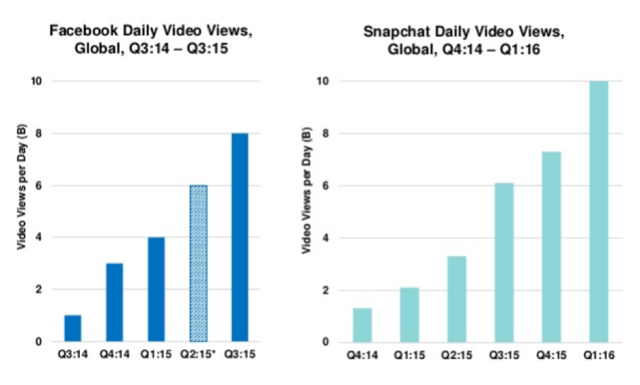
Snapchat Grows Spectacularly
From almost nothing in 2012, Snapchat has grown to account for over a third of total daily photo shares. Facebook continues its growth, but has been someone overshadowed by the messenger platform WhatsApp (Owned by Facebook) and Snapchat.
Snapchat, whose photo's are deleted as soon as they are viewed, looks like it dominates photo sharing, but marketers must not rush to the platform without a strategy. The whole point of Shapchat is the photos are only viewed once and then discarded. It's great for reaching millennials with certain B2C products, but if you're a B2B business the chances are Snapchap isn't going to be delivering much in the way of ROI anytime soon.
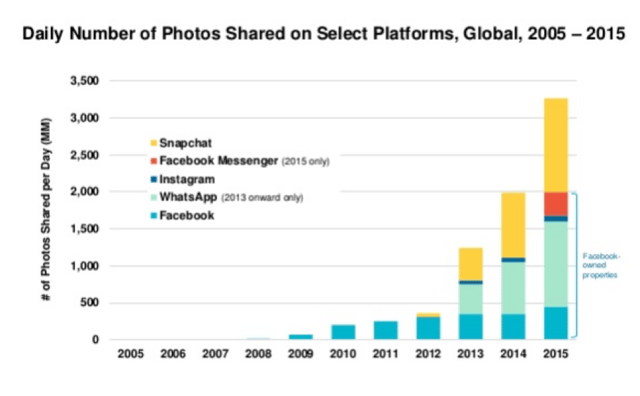
Messaging Apps Are Taking Over Communications Big Time
We've seen messaging apps like WhatsApp and Snapchat growing massively in photo and video sharing. The trend towards communicating with friends, via messaging apps, rather than broadcasting to one's social networks really picked up.
Monthly users of messaging apps have increased massively over the last couple of years, with WhatsApp reaching a huge 1 billion people, and Facebook Messenger and WeChat not far behind.
These messaging apps are now considerably outstripping established Social Networks like LinkedIn, Twitter and Instagram. Working out how to monetize these platforms will be the key challenge for their owners in 2016 and beyond. How they decide to do so will affect marketers immensely.
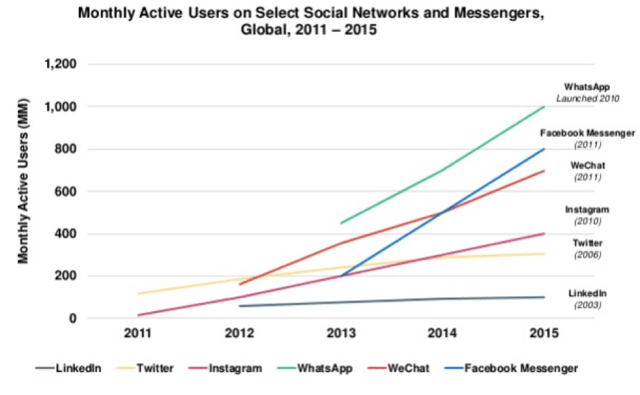
Voice Assistants Increasing In Popularity
As the technology has improved, voice assistants have more than doubled in popularity, being used by 65% of smartphone users in 2015. The implications for search are massive, as people will be increasingly interacting with their search engines via their voices, rather than their keyboards, which will significantly change the way people look for information ... and more importantly to us - how SEO can content marketing will work in the future.
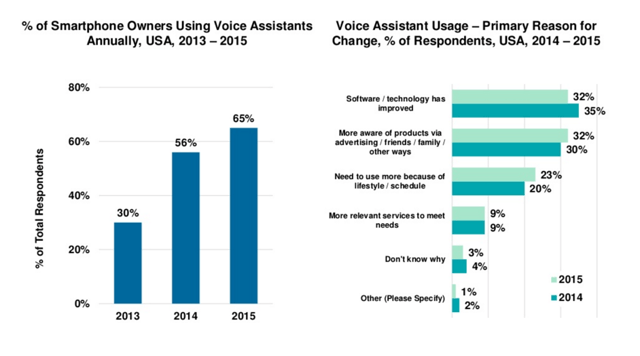
Additional Internet Trends Worth Noting:
- Take the focus off the remote and analog TV. Advertisers continue to be over-indexed in legacy media, spending proportionally more in TV and less in media such as mobile, where users clearly spend significantly more time.
- Millennials now make up 27% of the population so get used to them – they are currently the largest segment and the most able to change with the times
- Text search is so 2010 – the future is image and speech based searches. Moreover, images and video will become the de-facto means for communication as a whole
- Data-driven marketing is an explosive growth platform. We are migrating swiftly from a reactive to dynamic and predictive intelligence
- Coupled with this data, and its ability to target us in real-time comes the increased level of consumer concern toward personal privacy. The Snowden affect if you will.
- Video ads are working more and more efficiently. The advent of vertical video and full screen viewing has now properly tapped in to the natural consumption behavior on smartphones
- Global Internet users have surpassed 3 Billion; India has just supplanted the US as the world’s second-largest Internet market. Internet user growth remains consistent (led by acceleration in India), while smartphone user and shipment growth have slowed
- In the face of a slowing global economy, key macro growth drivers from the past 2 decades are less certain
- Internet advertising (particularly via mobile) continues to grow, but so does ad-blocking, pushing the envelope on development of more innovative ad formats
- New "online-first" brands have rapidly grown in popularity for the millennial generation with their focus on omni-channel and personalized distribution strategies
- In communication, video and images shared are growing as a means of storytelling; creators, consumers, and advertisers are taking part
- Messaging has evolved from simple, expressive conversation to business-focused use cases, with Asian platforms often leading the way
- More efficient and often more convenient than typing, voice-based interfaces are ramping quickly and creating a new paradigm for human-computer interaction
- Transportation is being re-imagined, as the rise of car computerization, autonomous driving, and sharing transform our understanding of mobility
- Looking to China, Internet leadership continues, as the country boasts global innovation powerhouses in e-commerce, messaging, travel, financial services, and on-demand transportation
- The proliferation of data generated by a multitude of devices has fostered tremendous business opportunity, but privacy concerns abound.
Well that's it from Mary Meeker this year. A couple of years ago she was all over wearable technologies and how that was going to impact us ... but that certainly simmered down.
If you want to know how to take advantage of these trends to increase your own traffic, leads, and sales, contact us for a free Inbound Marketing consultation.
THE BRIT AGENCY is a B2B Inbound Marketing Agency providing Inbound Marketing, Inbound Website Design and Inbound Sales services to companies around the world. We're focused on growing website traffic, qualified leads and sales, using the Inbound lead generation and marketing automation process.
THE BRIT AGENCY is a certified Gold Tier Hubspot Partner, a HubSpot COS certified Inbound Website Design Agency, a Shopify eCommerce Partner, and a certified "Google Badged Agency Partner". We have offices in Toronto and Barrie, Canada, and Salisbury, UK.
